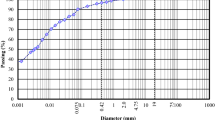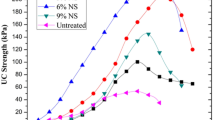Abstract
Iron filling and iron filling–cement mixture were used to improve the shear strength characteristics of Irbid clayey soil. For this purpose, five types of Irbid clay soils were obtained and mixed with iron filling and iron filling–cement mixture at different percentages. Two sets of prepared samples were mixed with the admixture. The first set was prepared by mixing the soil samples with iron filling alone at 2.5, 5.0, 7.5, and 10% by dry weight of the soil. The second set was prepared by mixing with iron filling–cement mixture at equal ratio of the same percentages of the first set. An unconfined compression test was performed in this study to measure the shear strength properties of the soils. The test results showed that the increase in the percentages of the iron filling and iron filling–cement mixture up to 10% will result in increasing the maximum dry density of the soil and increase the unconfined compressive strength and the secant of modulus of elasticity of the clayey soil. Also, the addition of iron filling–cement mixture increased the unconfined compressive strength and secant modulus of elasticity of the clayey soil higher than the addition of iron filling alone.













Similar content being viewed by others
References
Ahmed I, Lovell C (1993) Use of rubber tires in highway construction. ASCE, New York 166–181
Akawwi E, Kharabsheh A (2000) Lime stabilization effects on geotechnical properties of expansive soils in Amman, Jordan. J Geotech Eng 5
ASTM D-422 (1985) Standard method for particle-size analysis for soils, Sec., 4, 04.8: Soil and Rock; Building Stones, American Society for Testing and Materials, Philadelphia
ASTM D-698 (1985) Standard test method for moisture-density relations of soils and soil-aggregate, Sec., 4, 04.8: Soil and Rock; Building Stones, American Society for Testing and Materials, Philadelphia
ASTM D-2166 (1985) Standard Test Method for for Unconfined Compressive Strength of Cohessive Soil, Sec., 4, 04.8: Soil and Rock; Building Stones, American Society for Testing and Materials, Philadelphia
ASTM D-4318 (1985) Standard Test Method for Liquid Limit, Plastic Limit and Plasticity index for Soils, Sec., 4, 04.8: Soil and Rock; Building Stones, American Society for Testing and Materials, Philadelphia
Attom M, Shatnawi M (2005) Stabilization of clayey soils using hay material. J Solid Waste Techn Manag 31(2):84–92
Bell F, Coultherd J (1990) Stabilization of clay soils with lime. Munic Eng 7:125–140
Edil T, Bosscher P (1994) Engineering properties of waste tire chips and soil mixture. Geotech Test J 17:453–464
Edral C (1999) Effect of fly ash on swelling pressure of expansive soil. J Geotech Eng 4
Kamon M, Nontananandh S (1991) Combining industrial wastes with lime for soil stabilization. J Geotech Eng 117:1–17
Kennedy T, Smith R, Holgreen R, Tahmoressi M (1987) An evaluation of lime and cement stabilization. Transportation Research board, Washington, D.C. TRR (1119) pp 11–25
Lambe T, Whitman W, Robert V (1979) Soil Mech. Wiley, New York
Lee J, Saigado R, Bernal A, Lovell C (1999) Shredded tires and rubber–sand as lightweight backfill. J Geotech Geoenviron Eng 125:132–141
Mahe M, Gray D (1990) Static response of sands reinforced with randomly distributed fiber. J Geotech Eng 116(11):1661–1667
Muntohar S, Hantoro G (2000) Influence of rice husk ash and lime on engineering properties of a clayey subgrade. J Geotech Eng 5
Puppala A, Lovay N, Allen A (1996) Engineering behavior of lime-treated Louisiana subgrade soil. Transp Res 1546:24–31
Author information
Authors and Affiliations
Corresponding author
Rights and permissions
About this article
Cite this article
Attom, M.F. Shear strength characteristics of Irbid clayey soil mixed with iron filling and iron filling–cement mixture. Environ Geol 55, 781–788 (2008). https://doi.org/10.1007/s00254-007-1031-0
Received:
Accepted:
Published:
Issue Date:
DOI: https://doi.org/10.1007/s00254-007-1031-0




